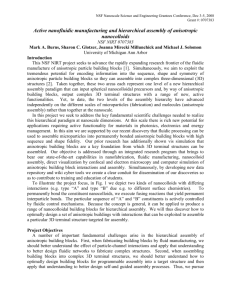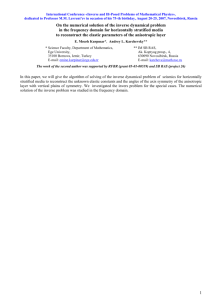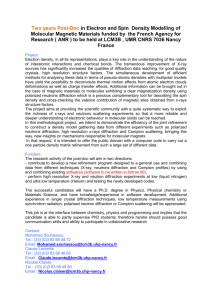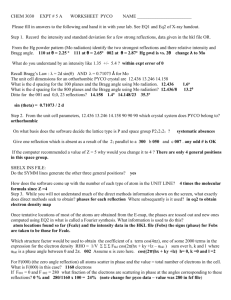Anisotropic Scale Factor
advertisement
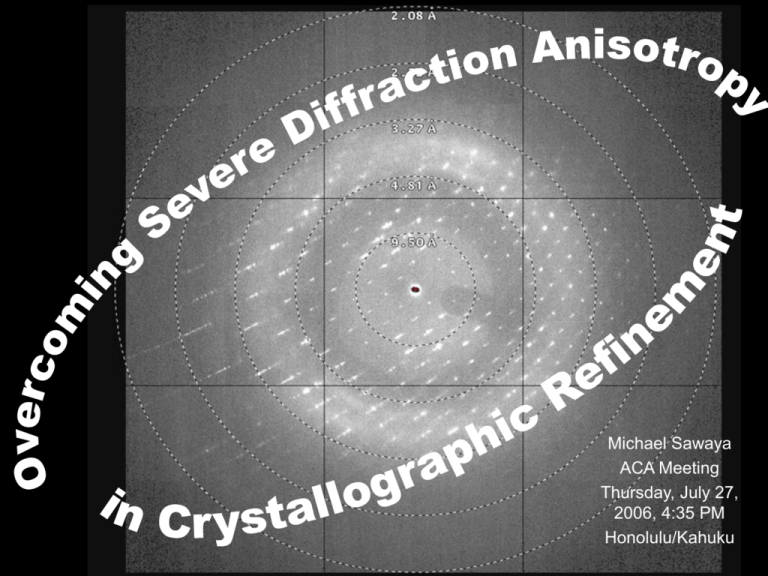
Michael Sawaya ACA Meeting Thursday, July 27, 2006, 4:35 PM Honolulu/Kahuku Diffraction Anisotropy diffraction strength differs with cell direction mean |F| vs. resolution c* a* b* c* c* a* b* ANISOTROPIC a* b* c* ISOTROPIC c* c* b* a* Diffraction anisotropy arises when then number of lattice contacts is less in one cell direction than another Myohemerythrin (PDB ID 2MHR) crystal packing viewed from two orthogonal directions The crystal diffracts to 1.3 Å along b*, 1.7 Å along a* and c* Sheriff & Hendrickson, (1987) Description of overall Anisotropy in Diffraction from Macromolecular Crystals. Acta A43, 118-121. View perpendicular to b View parallel to b Diffraction anisotropy presents two major problems to crystallographers Problem 1: choice of resolution boundaries of the data set •Clearly, one would like to chose an ellipsoidal boundary for anisotropic data. •a) Concentric ellipsoids more accurately describe the intensity contours of anisotropic data sets than do concentric spheres. •b) Reflection bounded by ellipsoidal shells will have the similar I/s and Rsym. •Currently available programs provide only spherical shells for selecting a resolution cutoff and reporting diffraction statistics. (An •Anisotropic data is best contoured using ellipsoidal shells anisotropic B is allowed in Scala, but is not recommended because parameters for this option are likely to be poorly determined.) The inadequacy of spherical shells in reporting diffraction statistics Problem 1 (continued) •1) Anisotropic data quality varies not only with resolution, but also with direction. •2) Within a spherical shell, data quality (I/s, Rsym) will be highly varied depending on direction. For example… 3) If one wishes to keep the strong data at high resolution, one is forced to accept the weak, poorly measured data bounded by the same spherical shell. Accept bad I/s, Rsym in high shell Must justify bad stats to peers •Same data set as previous slide, but bordered by spherical shells •4) If you discard the high resolution data, you discard the details of the electron density map. Which will it be? Problem 2: The need for an anisotropic scale factor for comparing Fcalc & Fobs c* Refinement of a structure c* Areas of poor agreement b* b* against anisotropic data will stall at a high R-factor the agreement between Fobs and Fcalc will be very poor |Fobs| has a directional dependence and |Fcalc| does not; An anisotropic scale factor must be applied to either |Fobs| or |Fcalc| to make them comparable. |Fobs | | Fcalc | plane h=0 plane h=0 Anisotropic diffraction is not modeled by TLS disorder parameters nor individual isotropic B-factors. How the anisotropic scale factor works. • Scale factor B=12 Å2 Same for all lattice directions (a*,b*,c*) • resolution • • • b11= +2 along a* Å2 Scale factor Scale factor Scale factor resolution resolution b22= -5 along b* Å2 • resolution b33= +12 along c* Å2 An anisotropic scale factor is a multiplicative factor like the overall B-factor. Like the overall B-factor, its value varies with resolution. But, unlike the overall B-factor, its value also varies with direction. It has three principle components, b11, b22, and b33 acting as B-factors along a*,b*,c* directions, respectively. An anisotropic data set can be made isotropic by applying the appropriate scale factor that increases |F| in weak diffracting direction or decrease |F| in the strong diffracting direction or a combination of both. “B”s can be positive or negative. Anisotropic Scale Factor Anisotropic tensor [ ] b11 b12 b13 b12 b22 b23 b13 b23 b33 The anisotropic scale factor components are obtained from a least-squares fit of the elements of an anisotropic tensor to Fobs. S(|Fobs|-k|Fcalc|)2 → min k=e- The value of k changes in the form of concentric elliptical shells from the center of the reciprocal lattice. The parameters b11 b22 and b33 correspond to the principal axes of the ellipse. Anisotropic scaling is increasingly employed in crystallography. – Molecular replacement • c* – b* • Phaser (MR_ANISO keyword) Refinement • • a* (b11a*2h2+2b12a*b*hk+2b12a*c*hl+b22b*2k2+2b23b*c*kl+b33c*2l2) Refmac CNS Anisotropic scaling dramatically improves R-factors (see The Effect of Overall Anisotropic Scaling in Macromolecular Refinement. Murshudov, Davies, Isupov, Krzywda and Dodson CCP4 Newsletter on Protein Crystallography Number 35. July 1998) – , But, a shortcoming in its formulation was newly revealed by the severe degree of anisotropy in our data set… and refinement was stalled. Crystal structure of a PE-PPE protein complex from M. tuberculosis. • PE and PPE are 2 families named for the conserved proline (P) and glutamate residues (E) near the Ntermini. • Large families – 100 PE members – 60 PPE members • Precise function not known – Associated with cell wall – Linked to virulence – Immune evasion by antigenic variation? • Prevalent in M.tb. and absent in humans – Drug target Domain organization of the PE and PPE proteins as reported in Nature 393:537-44. (1998) PE-PPE project • Michael Strong – Characterization of the complex - 28 different individual proteins tested – insoluble. - A complex of Rv2430c and Rv2431c guided by bioinformatics – Purification – Crystallization and Structure Solution PE-PPE Crystal parameters • Crystals are plates • Selenomethionine derivative for MAD • Long, rod shaped unit cell a=40.8 b=46.7 c=283.1 Rebecca Page Screen 14% iso-Propanol 0.07M Sodium Acetate trihydrate pH 4.6 0.14M Calcium Chloride dehydrate 30% Glycerol anhydrous Two complexes/asu •Space group P2221 –Fairly rare in PDB (0.03%) •Solvent content 42% PE-PPE crystals diffract anisotropically mean |F| vs. resolution ALS beamline 8.2.2 c -strong a- medium b-weakest a* b* c* Data used for phasing and refinement Data Collection Se used for refinement Se (peak) Se (inflection) Se (remote) Wavelength (Å) 1.0000 0.9796 0.9794 0.9719 Resolution limit (Å) 2.2 2.4 2.4 2.4 Rsym(%) (last shell) 16.8 (34.2) 10.8(35.6) 9.8(43.8) 10.5(42.6) I/s (last shell) 2.0 2.0 1.8 1.5 Total observations 233,050 120,481 58,582 112,996 Unique reflections 27,342 18,561 17,315 18,154 Completeness (%) 92.7 (78.6) 80.8(46.3) 74.7(35.5) 78.3(41.9) • Using standard spherical bins of resolution R-sym Data statistics for best data set 0.50 0.45 0.40 0.35 0.30 0.25 0.20 0.15 0.10 0.05 0.00 R-linear R-squared 4.7 3.8 3.3 3.0 2.8 2.6 2.5 2.4 2.3 2.2 16 14 I/sigma 12 I/s 10 In highest resolution shell 8 a* |F|/s 6.0 6 4 2 0 4.7 3.8 3.3 3.0 2.8 2.6 2.5 2.4 2.3 2.2 Resolution (Å) b* 1.8 c* 15.0 Phasing Statistics Phase Determinationb Se (peak) Se (inflection) Se (remote) Rcullisc (%, 20-2.4 Å, acentric/centric, isomorphous) 0.97/0.95 - 0.92/0.85 Rcullisd (%, 20-2.4 Å, anomalous) 0.76 0.94 0.85 Phasing powere(20-2.6 Å, acentric/centric) 0.50/0.35 - 0.72/0.55 Number of sites Mean overall figure of merit (before/after DM) • Just adequate 11 0.39/0.60 2.4 Å experimental electron density map • Connectivity good enough to see the helical fold. • Side chain density is weak or non existent. • Use Se sites as reliable markers for sequence registration • Go forward with refinement…maps should improve. PE protein PPE protein PPE motif Refinement yields only marginal improvement in electron density map • • Side chain density is still missing Refinement stuck – – – – • Check for twinning – • Refinement in P21 or P1 yielded no improvement in R factors Use TLS – • Twinning not indicated Check for pseudosymmetry – • Rwork=38.5% Rfree=43.4% No apparent way to improve the coordinates/R-factors. No new features apparent in electron density map. Unstable, R-factor shot up. Use 3.0 Å cutoff – R-factors improved, but map does not improve. Experimental 2.4 Å 2Fo-Fc 2.2 Å Looking to the literature for help Science, vol 300, pp. 1256-1262 • Lodowski et al. Supplemental methods, – • Zhang et al. – – – • “Because the diffraction pattern exhibited severe anisotropy, a 3-D ellipsoid was defined and merging R-factors and I/s were calculated in ellipsoidal shells. Diffraction data were then limited to the outermost shell that still contained significant data…” “Data observed to 2.5A resolution in the c* direction, but to only 3.3 A in the plane perpendicular to c*.” An ellipsoid of diffraction data, rather than the usual sphere, was used for scaling and refinement. Refers to Lodowski et al. for method. Let’s do the same Acta D, vol 60, pp. 1512-1518 Solution proposed by literature Equation of an ellipsoid 1=x2/a2 + y2/b2 + z2/c2 Where a, b, and c are the vertices of the ellipse. Set the following: a= 1/resolution limit along a*=1/2.2Å b=1/resolution limit along b*=1/3.2Å c=1/resolution limit along c*=1/2.2Å Resolution limits determined by the point were mean |F|/s drops below 2 for the given axis. See truncate output. To test whether a given reflection falls within the ellipsoid, calculate: x=component of d* along a* y=component of d* along b* z=component of d* along c* Plug a,b,c,x,y,z into equation above. Where the sum>1, discard reflection. Reflections before truncation 27,293 Reflections after truncation 20,053 Elliptical truncation produced a sharp drop in R-factors but no improvement in map. • Elliptical truncation yielded a – – • Details: – – • • TLS refinement is now stable, so it also contributes to improvement in R-factors. Most of the drop is in the high resolution shells 3.0-2.2Å, where much of the poorly measured data was discarded. 2Fo-Fc maps are still not improved. – – • Rwork= 38.5% →32.5% Rfree = 43.4% →36.2% Side chain density is still blobby as if only 3.5A resolution. No new features. Can’t improve model! Panic!! Clue: Average B of model coordinates =75 Å2. An effect artificially produced by the anisotropic scale factor. Big drop R-work • 6.0% drop in Rwork 7.2% drop in free Rfree Before truncation After truncation Adverse Side Effect of Anisotropic Scaling • • • • The effect of anisotropic scaling was observed by plotting the scaled |Fobs| as a pseudo precession photograph; appearance was compared before and after scaling. The adverse side effect of anisotropic scaling is to diminish the amplitude of well measured, high resolution reflections in the a*c* plane. These reflections contribute almost nothing to the electron density because anisotropic scaling diminished their amplitudes. The diminished contribution of these high resolution |Fobs| to the Fourier synthesis results in a map that appears to be low resolution. Fobs Fobs b* after scaling b* c* c* Isotropic, but high resolution |F|obs near c* are diminished Why anisotropic scaling might diminish high resolution |Fobs| • • • Imagine an ellipsoidal shell (Red ellipsoid) encapsulating all reflections in the data set were |Fobs|>2. The goal of anisotropic scaling is to transform the ellipsoid into a sphere (Blue sphere) by scaling |Fobs| by the “appropriate amounts” in the three principal directions. The “appropriate amounts” may be derived from 3 different approaches: – – – • • • decrease |Fobs| in the strong diffracting directions (SBij ≥0) Increase |Fobs| in the weak diffracting directions (SBij ≤0) A combination of both of the above (SBij =0). SBij ≥0 B11 (Å2): + B22 (Å2): 0 B33 (Å2): +++ SBij =0 ++ The choice of approach appears arbitrary; the results differ only by an isotropic B-factor (i.e. the radii of the blue spheres). REFMAC encodes the last option, constraining the amplitude gains in the weak diffracting direction to be equal to the amplitude decreased in the strong diffracting direction. Mathematically, this is equivalent to constraining the sum of the principle components of the anisotropic scale factor to be zero. – i.e. B11+B22+B33=0.0 REFMAC SBij ≤0 --0 Constraining SBij≤0 improved map, model building resumed. • • • • It seemed important to maintain the contribution of the well measured, high resolution reflections in the a*c* plane so that they may contribute to the electron density map and reveal new details. Of the three approaches, this effect can be best achieved by the constraint SBij≤0. In practice, the SBij≤0 constraint was achieved by first applying the REFMAC derived anisotropic scale factor to |Fobs|, followed by a negative isotropic B-factor (-10Å2). The anisotropically scaled |Fobs| was used as input for REFMAC refinement. SBij ≤0 SBij ≥0 SBij =0 B11 (Å2): + B22 (Å2): 0 B33 (Å2): +++ ++ x x REFMAC --0 2Fo-Fc maps showed a marked improvement. • 2Fo-Fc maps began to reveal carbonyl bumps, side chain density, and the presence of 72 waters, where previously we could see none. 2Fo-Fc using Automatic Anisotropic Scaling 2Fo-Fc using Improved Anisotropic Scaling Elliptical truncation produced a sharp drop in R-factors but no improvement in map. • Further model building yielded a Before truncation – 7.7% drop in Rwork – 4.9% drop in free Rfree – Rwork= 38.5% →32.5% →24.8% – Rfree = 43.4% →36.2% →31.3% • R-factor dropped in both high and low resolution shells R-work • Details: After truncation After negative B-factor correction and additional refinement R-factor improved throughout resolution range Refinement statistics • final Model Refinement Native Rworkf( 20 Å-2.1 Å) 24.7 Rfreeg( 20 Å –2.1 Å) 31.2 PDB ID code 2G38 Number of residues (protein/water) 499/73 Average B (main chain/side chain) 20.7/22.3 Rmsd bonds (Å) 0.007 Rmsd angles (°) 1.4 B-values (Å2 bonded) 1.6 Origins of diffraction anisotropy resemble those in myohemorythrin Strong diffraction Poor diffraction Anisotropic scaling of other proteins Protein Resolution in Resolution strongest in weakest direction direction Rwork Before & After Correction Rfree Before & After Correction PE-PPE 2.2 3.2 38.5->24.7 ↓13.8% 43.4->31.2 ↓12.2% Actin dimer 2.7 3.8 29.1->24.2 ↓4.9% 30.8->28.6 ↓2.2% Tim8-13 2.6 3.3 30.8->26.5 ↓4.3% 35.3->30.6 ↓4.7% • • • The technique of applying anisotropic scaling with SBij≤0 has helped in the refinement of structures of Actin dimer, and Tim8/13 complex. The improvement in R-factors and electron density maps have been more modest in these cases, as the anisotropy is less severe. The technique appears to be most helpful when the best and worst diffracting directions extend between 2.5 to 3.0, where water molecules are discernable. Procedures • Judge whether anisotropy is a problem. – – • If anisotropy is significant, determine the resolution limits along the three principle cell directions. – • For example B11= +6, B22= -14, B33= +9 use cad from CCP4 Apply a negative isotropic scale factor to the newly isotropic Fobs to restore the magnitude of those reflections weakened by the previous step. – – • • • Perform a cycle of refinement with Refmac or CNS. Note the anisotropic scale parameters (B11,B22,B33,etc.) listed in the PDB header For example B11= -6, B22= +14, B33= -9 Apply the negated scale factors to Fobs to create an isotropic data set. – – • I’ll make my truncation program available from http:www.doe-mbi.ucla.edu/~sawaya. Calculate the anisotropic scale parameters (for Fcalc). – – – • Note where mean F/s drops below 2 along the three principle directions. Truncate data using ellipsoidal limits. – • Look at the anisotropy graph from truncate (loggraph truncate.log) Does mean F/s drop with different slopes along the 3 principle directions? Negate the most positive component from the previous step (e.g. +9 → -9). Use cad again. Use this scaled Fobs for refinement. -all these steps are performed by the diffraction anisotropy server http://www.doe-mbi.ucla.edu/~sawaya/anisoscale/ Acknowledgements • • • • • Michael Strong Shuishu Wang Duilio Cascio Alex Lisker David Eisenberg


